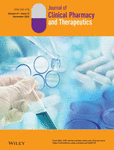Optimal exposure to docetaxel in adjuvant chemotherapy for early-stage breast cancer
Funding information: Fujian Provincial Health Commission, Grant/Award Number: 2019-2-53; Xiamen Municipal Bureau of Science and Technology, Grant/Award Number: 3502Z20214ZD2152
Abstract
What Is Known and Objective
Drug-induced neutropenia is the main reason for the dose limitation of docetaxel in patients with breast cancer. The area under the drug concentration-time curve (AUC) of docetaxel is associated with neutropenia. However, the optimal exposure to docetaxel for receiving postoperative adjuvant chemotherapy remains unclear. Therefore, we aimed to evaluate the relationship between the docetaxel AUC and neutropenia, identify potential influencing factors, and explore the best monitoring target for docetaxel when treating patients with early-stage breast cancer using a population pharmacokinetic (PopPK) model.
Methods
Docetaxel plasma concentration, demographics, clinical data, and related laboratory data were collected. PopPK analyses were performed using a nonlinear mixed-effect modelling program. The docetaxel AUC was determined using the maximum a posteriori Bayesian (MAPB) method. The docetaxel exposure-toxicity threshold measured from the AUC for neutropenia was determined using the receiver operating characteristic (ROC) curve. The correlation between docetaxel exposure and neutropenia was analysed using multivariable logistic regression.
Results
Among the 70 participants, 47 (67.1%) developed severe neutropenia. The PopPK analysis showed that the typical drug clearance (CL) rate was 37.4 L/h. Age was a significant covariate of CL rate, and aspartate aminotransferase and albumin levels were covariables of the volume of distribution. The multivariable regression analysis showed that AUC >3.0 mg.h/L (odds ratio [OR], 5.940; 95% confidence interval [CI], 1.693–20.843; P = 0.005), platinum use (OR, 0.156; 95% CI, 0.043–0.562; P = 0.005) and baseline haemoglobin level (OR, 0.938; 95% CI, 0.887–0.993; P = 0.027) were significant factors influencing the occurrence of grade 3/4 neutropenia. The AUC of first cycle may not predict the occurrence rates of grade 3/4 neutropenia in later cycles.
What Is New and Conclusion
We developed a docetaxel PopPK model for patients with early-stage breast cancer. Age and AST and ALB levels were significant covariates. AUC estimated using the MAPB method can predict the toxicity of docetaxel in patients with breast cancer. Docetaxel AUC >3.0 mg.h/L, absence of platinum use and low baseline haemoglobin level were risk factors for docetaxel-induced grade 3/4 neutropenia.
Study Registration
Chinese Clinical Trial Center Registry (ChiCTR2200056460).
CONFLICT OF INTEREST
The authors have no conflict of interest to report.
Open Research
DATA AVAILABILITY STATEMENT
The datasets used and/or analysed during the current study are available from the corresponding author on reasonable request.




